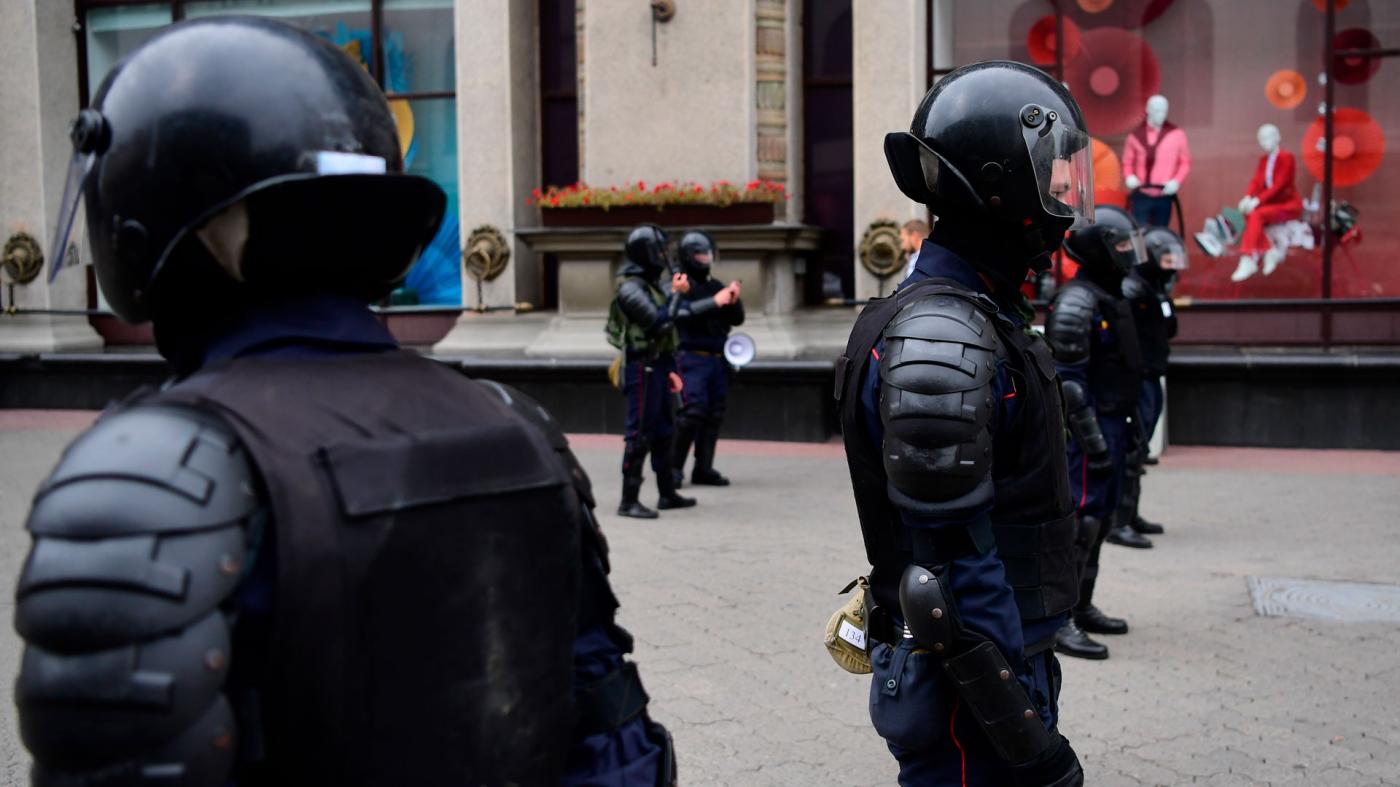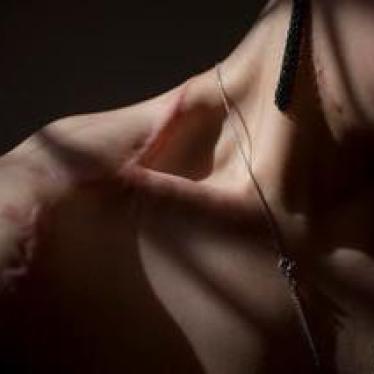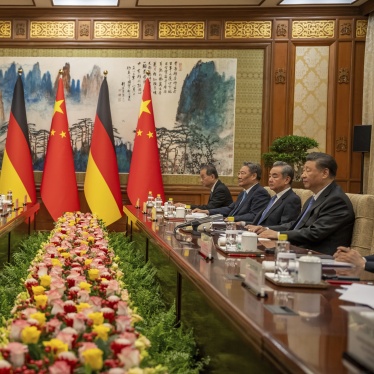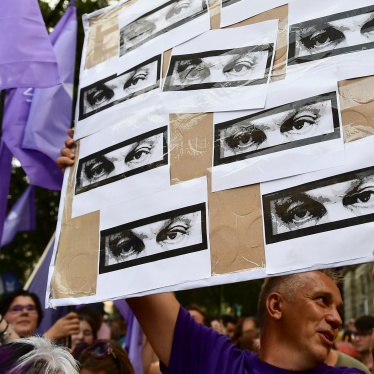When protests flared up across Belarus over the hotly contested August 9 presidential elections, Ales N. joined one of the first demonstrations in the streets of Minsk, but on August 11, the 30-year-old IT worker had no such plans. He was tired and had a backlog of work. At 5 p.m., he was cycling home through the city center before the protesters started gathering. He felt no apprehension – until two riot police officers stopped him and demanded to see his phone. Ales refused. “What do you want with me?” he said. “I’m just riding my bicycle – is that forbidden?
One of the officers led him to a green police van and the other wheeled his bike away. In the van, Ales saw two men face down on the floor, and when asked again to show his phone, he cooperated, hoping they would let him go. Flipping through his photos, riot police officers found a video of police dispersing a protest from the day before.
And that’s how it all began.
While working in Belarus this August, my colleague and I interviewed dozens of people who were mistreated and even tortured by police and security forces in the days following the disputed August 9 presidential. Some were in fact detained during the protests against President Alexander Lukashenka’s controversial claim to have won the election. Others, like Ales, were grabbed by police officers at random – at that time, authorities seemed to believe that simply being outside after 6 p.m. constituted an expression of support for the opposition. Some endured what they called “the light version” of police abuse, which amounted to several days of incarceration in overcrowded detention facilities, beatings and humiliation in police vans, along with random kicks or punches. Many others were less lucky.
Ales, the very last person I interviewed on that trip, was clearly among the “less lucky” ones.
After seeing the video on his phone, the police beat Ales on his legs, ribs, and face with their batons, feet, and gloved fists, he said. The police wore black – and their faces were covered by black masks. Then, they put him on the floor, between two other men, and a few minutes later they beat him some more, yelling that he was a “coordinator” and “won’t leave here alive.”
The riot officers then dragged Ales to a yellow bus with more detainees in it, and made him crawl towards some senior officer who yelled: “Are you one of the organizers? How much are they paying you?” They took him back to the van and threw him to the floor again. As the number of the detainees inside the van grew, Ales hoped the worst was over. But the riot officers came back and ordered him to again unlock his phone. Ales refused, fearing they would use the phone to identify and arrest his friends.
The riot officers raised the stakes. They called another senior officer. That man was in his forties, with a pot belly, Alex said, adding that he was bald and wore some sort of beret, a black uniform, and a black mask. He threatened that unless he cooperated, “he’d stick his truncheon up my ass.” He cut Ales’ shorts and his underwear on the back, put a condom over the truncheon, and made good on this threat, Ales said. Then, he pulled the baton out and demanded the password again. Ales still refused and was kicked and punched – bits of his two front teeth broke off, he said. Then, the senior officer forced Ales to pull the soiled condom off the truncheon.
Sometime afterwards, the police moved Ales and the others to a grey van and locked him inside in a tiny cell with three other people already crammed into it. The ride was long, stifling, and unbearably hot. Finally, the van arrived at what Ales later realized was Zavodskoy District Police Station. The detainees were ordered to get out.
He saw that riot police had formed a corridor, and the detainees were forced to run through it. “They were hitting us with their sticks at random, demanding we run towards the grass patch and flop on [it], face down.” There were some 50 people in total lying there. A police officer approached each person to record their personal data, someone took their belongings away, and they were photographed.
Yet again, an officer demanded the password for his phone. “When I refused, he hit me twice with a truncheon on my body.” Ales could feel his perineum was bruised and swollen and asked to see a doctor, but they didn’t care, he said. Another man there, Mikhail, was diabetic and was refused his insulin, so he eventually fainted, Ales said. They had an ambulance take him away but refused to let Alex go in the ambulance too.
When Ales almost fainted from dizziness, police officers gave him some water and he felt marginally better. A bit later, they allowed him to go to the toilet. He was distressed by the extent of the bruising and again pleaded for medical assistance, all in vain. Eventually, at around 6 a.m., the police took the detainees to a parking lot and made them stand there, facing the wall, with their hands zip-tied behind their backs for another 8 to 9 hours.
Ales’ shoulders hurt and his hands were growing numb, he said. Finally, an officer arrived with a stack of rubber-stamped charge sheets for participating in an unsanctioned gathering, chanting slogans, waving hands, and disturbing public order. Just after 5 p.m., two prison vans arrived for the detainees. An officer crammed Ales into a cell inside the second van and kicked him in the stomach and in the back. The windowless van moved for some 30 minutes, then it stood still for another 15 minutes – it was stifling hot and airless. Then, it started moving again – that part of the ride was bumpy, and Ales’ head kept hitting the metal wall, but he was too worn out to care.
Once the van finally arrived at the Okrestina Detention Center on the outskirts of Minsk, the detainees had to run through another “corridor” of officers who, armed with truncheons, showered them with random blows.
The officers there cut off the detainees’ zip-ties and herded them into a roofless concrete cell that was five-by-five meters, with bars for a ceiling. There were 119 people, Ales counted. “We were like fish in a barrel.” Empty plastic bottles in the corner soon started overflowing with urine.
After midnight, a guard came to ask whether anyone needed an ambulance. Ales said he did. A medic examined him and got him an ambulance straight away.
At around 2 a.m. on August 13, Ales arrived at the Minsk Emergency Hospital. They diagnosed him with hematomas to his scrotum, perianal area, and left eye, as well as a cranial trauma and a concussion. Photos that he shared with me clearly showed horrific bruising. When we spoke – two weeks after his ordeal – a dark purple bruise still circled his left eye, and I could see the damage done to his front teeth.
Ales filed a complaint with the Belarussian Investigative Committee and a preliminary inquiry is ongoing. However, like many others who stepped forward with official complaints, Ales is anxious about the possibility of getting pressure and retaliation.
To keep this from happening, the eyes of the world should remain on Belarus.




